Paris has become well-known for being home to distinct landmarks, for its sentimental aura, and for having a very alive thoroughfare system. Despite this, over the years it has grappled with increasing vehicular congestion and degrading air quality. Fortunately, Paris Pedestrianisation is increasingly multiplying and making the city’s streets walker-friendly. One considerable move from the city is the “Code de la Rue,” a law that plans to resolve some of these pressing issues.
The Code de la Rue
The Code de la Rue is a set of transportation reforms that was launched in 2021 by Mayor Anne Hidalgo. The initiative has six principles:
- Protecting pedestrians
- Reinforcing the role of municipal police
- Enhancing safety for children and people with disabilities
- Ensuring accessibility
- Supporting children with bike workshops and a “bike passport”
- Combating dangerous behaviours and noise pollution
The Code de la rue implements a prohibition of cycling on sidewalks to promote pedestrian safety. Opposingly, planners are attempting to expand visitor paths for seniors, those living with disabilities, and minor organisms providing sophisticated amenities such as knowledgeable firmness and guidance for simplified acre partners. Subsequently, specific roadside parking opportunities can be updated and the private space to will increase safeguarding anybody who is underage or wheelchair-going.
The impact of the Code de la Rue
The Code de la Rue has been met with mixed reactions. There has been criticism from some drivers and businesses regarding the Code de la rue initiative, claiming that it has made transportation in Paris more challenging. However, many have applauded the initiative for its dedication to creating a city that is pedestrian-friendly.
The Paris City Hall conducted an investigation that came to the conclusion that the Code de la rue has led to abolished gridlock and enhanced atmosphere purity. Moreover, it came to reveal that this shift has sparked people to take up strolls or engage in cycling more evenly using cars. It spotlights what promises to become when regarding stimulus to pedestrian-oriented streets in the capital of France.
The Code de la Rue is at its starting point at present, but it has the capability to cause a forceful reverberation on people’s procession through Paris. If this campaign manages to become successful, this could foment future congenial strategies for pedestrian-oriented streets in other international cities.
According to the city’s mayor, Anne Hidalgo in a recent tweet, the Code de la rue scheme was launched to make Paris an enjoyable area to stroll around. She emphasized pedestrian and cyclist needs, along with public transportation, in order to prioritize them. Apart from making walking comfortable, Hidalgo furthered her point of view on this matter, noting the procedure would help reduce vehicular traffic and sky pollution levels. She concluded that implementing the Code de la rue was indispensable to improving clean and comfy environments across the capital.
Anne Hidalgo is leading a daring project that is making the city more people-oriented – the Code de la rue. Reactions to this are blended, but also highly positive because of the favorable impact it could bring. Its success in the future is uncertain, however, it is clearly seen that the Mayor is doing her utmost to ensure “Paris pedestrianisation” is improved as much as possible.




